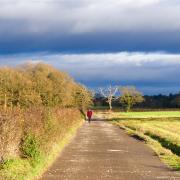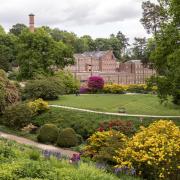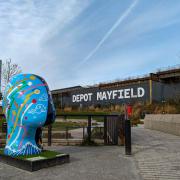Vale Royal retains a sense of significance, despite the local government borough’s abolition a decade and a half ago.
Edward I chose the name when siting a mighty abbey in the late 1200s, and his regal coinage lives on attached to an events venue and renowned golf course, as well as to other landmarks in the vicinity.
The great castle-builder of Wales supposedly founded the Cistercian monastery in thanks for his deliverance following a stormy crossing of the English Channel.
Although never the largest in Christendom, as Edward had decreed, the abbey church was still enormous, rivalling Westminster Abbey in size. Its construction was repeatedly delayed by financial constraints, structural disasters and sometimes violent disagreements.
Edward’s great-grandson the Black Prince reinvigorated the project and the building was substantially complete by the reign of his son Richard II. Unremarked in the middle of a fairway behind the house are a few remnants of reconstituted medieval masonry known as the ‘Nun’s Grave’, marking the site of the chancel.

The White Friars, whose early reputation for pious asceticism had become tainted by accusations of treason, murder and corruption, were finally evicted when the monastery was dissolved under Henry VIII, despite the last abbot’s desperate attempt to bribe Thomas Cromwell into a reprieve. The estate was sold to Thomas Holcroft, a courtier, soldier and politician. He 'plucked down' the church and built the first house on the site, which later passed to the Cholmondeley family and remained the seat of the Delamere baronets for more than 300 years. The current house dates visibly from the 19th century, but incorporates remnants of the cloister and other monastic fixtures, including a roof truss in the south wing that has been dated by tree rings to the 15th century and probably spanned the monks’ refectory.
In 1837 the Grand Junction Railway was driven through the district between Crewe and Warrington. Joseph Locke, an associate of George and Robert Stephenson and friend of Isambard Kingdom Brunel, bridged the Weaver with a red-sandstone viaduct of five arches, which now carries the West Coast Main Line.
Three locks were built on the Weaver Navigation a short distance upstream: the present-day sluice was originally a lock, and the contemporary ‘large lock’ of the 1860s was partnered by an even larger one in around 1890, designed to accommodate barges towing three others side-by-side. Its construction required the adjoining lock-keeper’s cottage to be moved 20 yards downstream.
Hartford Bridge, popularly known as the Blue Bridge, carries the A556 high over the Weaver and was built in 1938 with art deco touches. It was unsuccessfully proposed for heritage listing in 2012, prompting the unimpressed assessors to describe it as 'modestly detailed and functional in its design' and lacking 'any technological or design innovation'. It is rumoured to have once incorporated a lifting mechanism to allow tall ships to pass below, but careful research suggests that this facility applied only to a temporary platform erected during construction.

THE WALK
1. From the front of Hartford Hall, turn right along School Lane, passing the end of Woods Road (right) and Lodge Lane (left). Continue past the impressive frontage of Whitehall, a Grade II listed house of 1835. It is a rare work of John Douglas Senior, the father of the eminent architect who was responsible for much of the Victorian restoration of Chester. Continue past the old school and the junctions with Whitehall Drive and Old Vicarage Lane.
2. Turn right into Stones Manor Lane, signposted to Hartford Manor Primary School and walk down to the end of the road. Beyond Marshall’s Court, turn right before the school entrance onto a footpath that shortly leads to the circular ironwork entrance to Marshall’s Arm Local Nature Reserve, co-designed by pupils from Hartford High School. Follow the path beyond, which leads down through Greenbank Wood to the left of a stream, with occasional footbridges and steps. After one such footbridge, you pass under a pipeline.
3. When you reach the path junction by Marshall’s Arm (an abandoned former course of the River Weaver), turn right, signposted to Hartford Blue Bridge. Pass a carved stone ball and then leave the reserve through a gate onto the riverside path, which you follow towards the Blue Bridge.
4. As you approach the bridge, you reach a gate with an adjoining kissing gate. Here, rather than following the main route up to the right, take a path on the left that passes under the bridge, close to the water’s edge. Leave the river thereafter, turning right to follow the track parallel to the A566 up to a car park. Turn left onto a drive into Vale Royal Wood.
5. After half a mile, the drive passes under the Vale Royal railway viaduct. Stay on the drive to a gate. Here, you can shorten your walk by turning left and jumping to step 10; otherwise, carry on, climbing gently to a further gate and kissing gate. The track beyond leads up past Vale Royal Abbey. Beyond the main house, follow the road, now metalled, past the gabled former stables on the left.

6. When the metalled road bears right, cross and pick up a track (the original Vale Royal Drive) that continues ahead through a gate. Ignoring crossing paths, follow the track to Whitegate village.
7. Having explored the churchyard and village, retrace your steps past the Lodge Cottage and, before the entrance to Sutton Field on your right, turn left into Church Wood, owned by the Woodland Trust. Bear right at the noticeboard and follow the main path, ignoring turnings to right and left. At the far end, beyond a gate, turn right to re-encounter Vale Royal Drive. Turn left for a short distance, then take a path on the left, by a footpath sign. This leads shortly to a cul-de-sac where you turn right out to St Mary’s Drive.
8. Cross straight over onto a path between houses to a gate onto the golf course. Exercising due care and attention, pass the 18th tee and take the ‘third exit’ at a five-way crossing of paths, as indicated by the yellow waymark. Carry on past the 15th tee, forking right by a pond. Keep straight on past the 9th and then, just beyond the 13th tee, turn left as waymarked. Almost immediately, turn right into Rookery Wood and drop downhill to a footbridge. Bear right at the far side of the wood.
9. Ignoring the wooden footbridge and steps up to a kissing gate into the field on your left, keep within the wood on a narrow path winding ahead down the valley through the trees. At one point, a makeshift boardwalk leads across a muddy spot, and a sign on the right warns of deep mud in the valley bottom. When they meet the drive you walked earlier, turn left, ignoring a footpath on the right. Just after a gate across the drive, turn right and follow the track down to a bridge over the Weaver weir-stream.

10. Continue to cross the two bridges over Vale Royal Locks. Turn left on the far bank and, beyond the locks, continue below the lock-keeper’s cottage. Pass under the railway viaduct again and continue along the riverside path for half a mile back to Blue Bridge.
11. Go under the bridge, then turn right up a path leading up to the A556. Turn right and cross the bridge, then continue beside the main road up to the lights at the end of School Lane. Turn right to return to the Hartford Hall.

Hartford Hall
Hartford Hall is a Grade-II-listed 16th-century manor house, though to be honest you wouldn’t know it from the
modernised, mock-Tudor exterior. There are visible traces of its antiquity inside, however, where a room known as the
nun’s room, and some Jacobean plasterwork, can be viewed by interested customers. Behind and beside the
building is a large garden with its own lake, numerous picnic tables and ample overflow parking. Visitors with dogs
can choose a doggy treat from a special menu and will find ample space for their four-legged friends in the garden
and bar areas. Matthew Abbott, the general manager, tells me that the hotel’s 20 rooms in various
configurations have been recently refurbished, and notes that half of them are designated as dog-friendly.
The majority of the ales on sale are from the Robinsons stable, with Weetwood’s Cheshire Cat also on handpump as
a regular. Prosecco fans will enjoy 20 per cent off on Fizzy Friday, and other regular promotions include two-for-one deals
on hand-pulled pizzas on weekdays between 2pm and 6pm, and Chippy Tuesday with discounted fish and chips.

Compass Points
Area of walk: Hartford near Northwich
Start point: Hartford Hall Hotel CW8 1PW
Distance: 6¼ miles/10 km
Time to allow: 2–3 hours
Map: OS Explorer 267: Northwich & Delamere Forest
Refreshments: Hartford Hall hartfordhallcheshire.co.uk 01606 786400
Practicalities: Some steps and root-strewn woodland paths; unsurfaced sections may be muddy after rain. Cross golf
course with care. Hartford is served by buses from Chester and Northwich, and by trains between Crewe and
Runcorn.



























